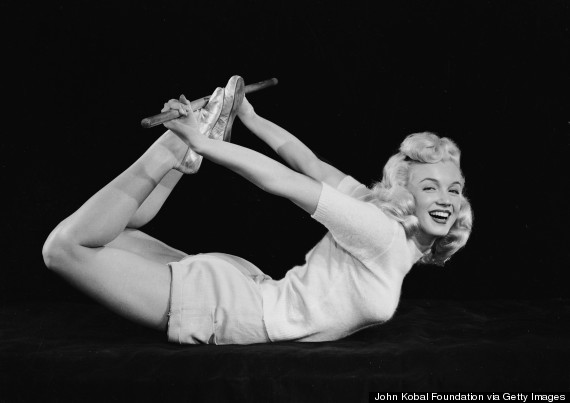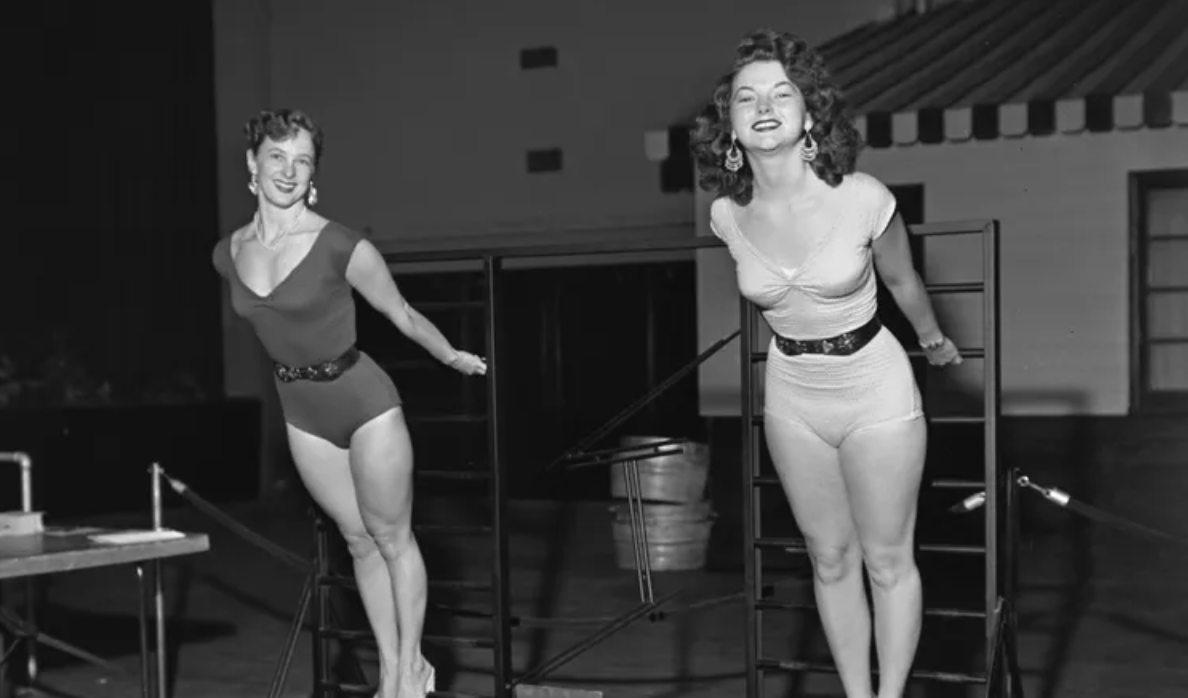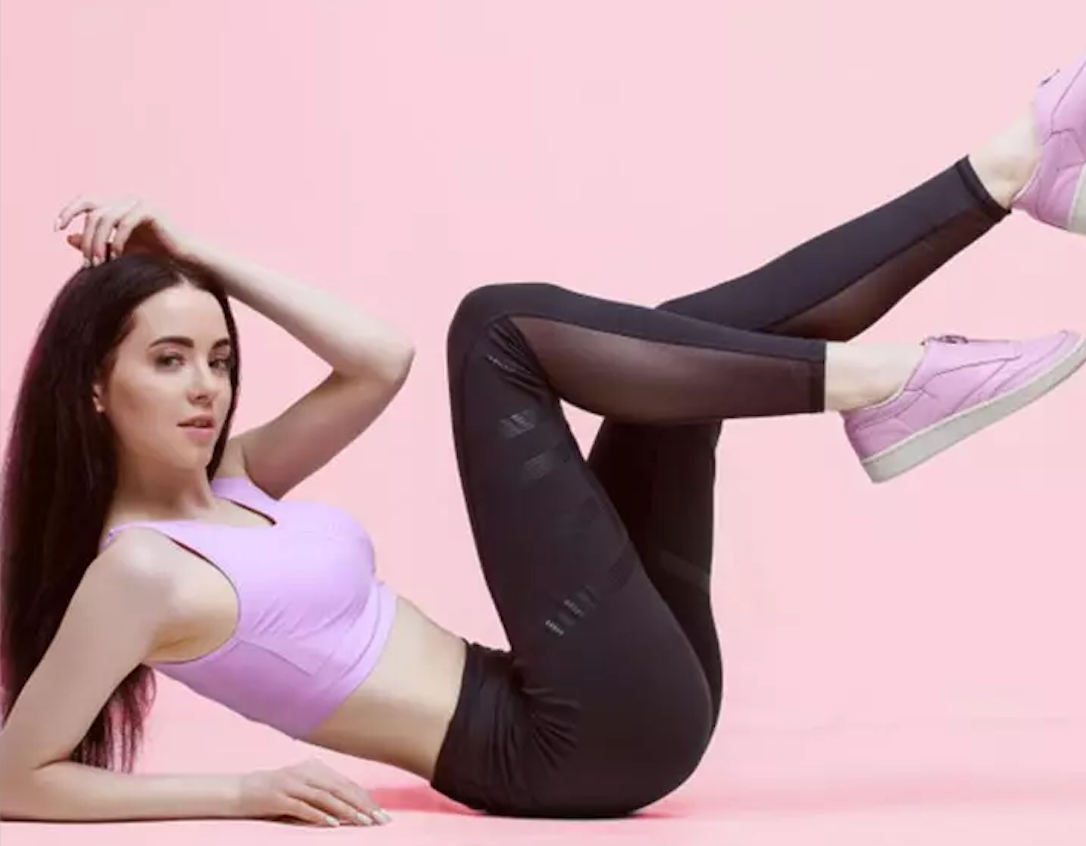Working out is an essential aspect of our daily lives. With the constant change in fashion trends, workout clothes have also undergone significant transformations. Join us as we delve into the evolution of women's workout clothes through the decades to find out how they have impacted the world of fitness.
workout clothes - the history
The evolution of women's activewear throughout history is a fascinating journey that reflects the changing attitudes towards fitness, fashion, and gender roles. From the early days of restrictive corsets and heavy skirts, to the liberation of more practical and comfortable clothing, to the current era of stylish and functional activewear that empowers women to pursue their goals with confidence and flair, the evolution of women's activewear has been marked by constant innovation, adaptation, and creativity.

The 1920's - The Age of Reform
The 1920's was a transformative decade, often referred to as the Roaring Twenties or the Jazz Age. In many ways, this period marked a break from the past, with significant cultural and societal changes taking place. Among these changes, women were embracing new forms of freedom, challenging traditional gender roles and social norms.
One way in which women expressed their newfound independence was through fashion. The restrictive clothing of the past, such as corsets and long skirts, was replaced by looser, more comfortable garments. The iconic flapper dress, characterised by its straight silhouette and knee-length hemline, became a symbol of the era. It was made of lightweight materials, such as chiffon and silk, that allowed for more movement and freedom.
Along with the flapper dress, women began to wear shorter skirts and sleeveless tops for exercise routines, such as dancing, swimming, and tennis. This represented a departure from the modest clothing of the past, which had been designed to conceal women's bodies. Instead, women were now celebrating their bodies and their ability to move freely.
The fashion trends of the 1920's reflected broader changes in society, such as the increasing visibility of women in the public sphere and their growing economic independence. Many women had entered the workforce during World War I, and they were now enjoying greater financial autonomy. This newfound independence was reflected in their clothing choices, which signaled a desire for greater personal freedom and self-expression.
Overall, the fashion of the 1920's represented a significant shift in women's roles and expectations. Women were no longer content to be passive objects of male desire, but rather active participants in their own lives. Through their clothing, they were able to express their newfound freedom and independence, paving the way for the feminist movements of the decades to come.

The 1930s - The Rise of the Jumpsuit
The 1930's saw a continuation of the trend towards more comfortable and functional clothing for women, as well as the emergence of new styles and silhouettes. One of the most notable additions to women's wardrobes during this time was the jumpsuit, which was designed to be worn for a range of physical activities, from exercise routines to outdoor adventures.
The jumpsuit was a one-piece garment, typically made from lightweight fabrics such as cotton or linen, that allowed for ease of movement and flexibility. It featured a zippered closure that made it easy to put on and take off, and often had a belted waist to provide a flattering silhouette.
The jumpsuit quickly gained popularity among women who were looking for practical, yet stylish clothing options. It was seen as a versatile piece that could be dressed up or down, depending on the occasion. For more casual settings, women would wear a jumpsuit with sandals or sneakers, while for more formal events, they would accessorise with jewelry and heels.
One of the key features of the jumpsuit was its ability to blur the lines between traditional gender roles in fashion. While jumpsuits were initially designed for men, they quickly became popular among women who appreciated the practicality and comfort of the style. In wearing a jumpsuit, women were able to challenge traditional notions of femininity and express their desire for clothing that was both functional and fashionable.
Overall, the jumpsuit was an important addition to women's fashion during the 1930's, and its popularity continued to grow throughout the following decades.

The 1940s - The War Years
During the war years of the 1940's, many women became involved in physical activities as a way of staying fit and healthy. This was partly due to the demands of wartime work, which often required physical labor, but also reflected a growing interest in exercise and fitness among the general population.
As more women became involved in physical activities, there was a growing demand for workout clothes that were designed specifically for women's bodies and needs. Women's workout clothes during this period were designed to be functional and durable, with an emphasis on comfort and ease of movement.
Clothing styles included shorts, pants, and sleeveless tops, which were made from lightweight fabrics such as cotton or rayon. These materials were breathable and allowed for freedom of movement, making them ideal for activities such as jogging, aerobics, and dance.
In addition to being functional, women's workout clothes during this period also reflected broader changes in fashion and culture. The war years marked a time of great social upheaval, with women taking on new roles and responsibilities both at home and in the workplace. This newfound independence was reflected in the clothing styles of the time, which were more practical and utilitarian than the fashions of the past.
Overall, the workout clothes of the 1940's represented an important shift in women's fashion and cultural expectations. They were designed to meet the needs of active, independent women, and reflected a growing interest in physical fitness and health.

The 1950s - The Rise of Sportswear
The 1950's marked a significant shift in women's fashion, as sportswear began to emerge as a popular trend. With a growing interest in physical fitness and leisure activities, women began to seek out clothing that was both functional and fashionable, with an emphasis on comfort and ease of movement.
One of the most notable developments during this period was the emergence of fitted tops and shorts made from stretchy fabric. These garments were designed to hug the body and provide support and flexibility during physical activity. They were often made from materials such as spandex, which allowed for a greater range of motion and helped to prevent chafing and discomfort.
Another key development during the 1950's was the rise of the iconic sweatshirt and sweatpants. Originally designed as athletic wear for men, these garments quickly became popular among women who appreciated their practicality and comfort. Sweatshirts and sweatpants were made from soft, cozy materials such as cotton or fleece, and featured elastic waistbands and cuffs for a snug fit.
In addition to being functional, sportswear during the 1950's also reflected broader changes in fashion and culture. The post-war period was a time of great optimism and prosperity, with an emphasis on leisure and relaxation. This was reflected in the popularity of sports such as tennis, golf, and swimming, and the clothing styles associated with these activities.
Overall, the sportswear trend of the 1950's represented a significant shift in women's fashion and cultural expectations. It reflected a growing interest in physical fitness and leisure activities, as well as a desire for clothing that was both practical and fashionable.

The 1960s - The Age of Revolution
The 1960's was a decade of significant social change, marked by a growing sense of liberation and experimentation. Women's fashion reflected these changes, with a focus on bold colours, prints, and patterns. This was true of workout clothes as well, which became more vibrant and expressive during this period.
One of the most iconic workout garments of the 1960's was the leotard. This one-piece garment was designed to be form-fitting and flexible, allowing for ease of movement during exercise. Leotards were often made from stretchy materials such as nylon or Lycra, and came in a range of colors and prints. They were typically worn with tights or leggings, which provided additional support and coverage.
Tights and leggings also became more popular during the 1960s, as women sought out clothing that was both functional and stylish. These garments were made from a variety of materials, including cotton, nylon, and polyester, and often featured bold prints and patterns such as stripes, polka dots, and geometric shapes.
In addition to being more colourful and expressive, women's workout clothes during the 1960's also reflected a growing interest in fitness and physical well-being. This was a decade marked by the rise of aerobics and other forms of exercise, as well as a growing awareness of the importance of staying active and healthy.
Overall, the workout clothes of the 1960's represented an important shift in women's fashion and cultural expectations. They were designed to be both functional and fashionable, reflecting a growing interest in physical fitness and a desire for greater self-expression.

The 1970s - The Era of Aerobics
The 1970's were marked by a growing interest in fitness and exercise, and this was reflected in women's workout clothes of the era. As aerobics and other forms of group exercise became more popular, women sought out clothing that was both fashionable and functional, with an emphasis on comfort and ease of movement.
One of the most iconic garments of the 1970's workout scene was the leotard. This one-piece garment was designed to be form-fitting and flexible, allowing for ease of movement during exercise. Leotards were often made from stretchy materials such as spandex or Lycra, and came in a range of colours and patterns. They were typically worn with leggings or tights, which provided additional coverage and support.
Headbands also became a popular accessory during the 1970's workout craze. These were often made from stretchy materials such as terrycloth, and were designed to keep sweat and hair out of the face during exercise. Headbands were available in a range of colours and patterns, and were often worn as a fashion statement as well as for practical reasons.
Perhaps the most iconic garment of 1970's workout fashion, however, was the leg warmer. These knit accessories were designed to be worn over leggings or tights, and provided warmth and comfort during exercise. Leg warmers came in a range of colours and styles, and quickly became a popular fashion accessory both in and out of the gym.
Overall, the workout clothes of the 1970's represented a significant shift in women's fashion and cultural expectations. They were designed to be both functional and fashionable, reflecting a growing interest in physical fitness and a desire for greater self-expression.

The 1980s - The Decade of Spandex
The 1980's was a decade marked by excess and extravagance, and this was reflected in women's workout clothes of the era. As fitness and exercise continued to gain popularity, workout clothes became increasingly tight-fitting and flashy, with an emphasis on bold colours and eye-catching designs.
One of the most iconic garments of 1980's workout fashion was the leotard. These one-piece garments were designed to be tight-fitting and form-flattering, with an emphasis on accentuating the curves of the body. Leotards were often made from stretchy materials such as spandex or Lycra, and came in a range of colours and patterns, including neon and animal prints.
Tights and high-cut shorts also became popular during the 1980's workout craze. These garments were designed to be tight-fitting and stretchy, allowing for ease of movement during exercise. High-cut shorts, in particular, were often worn with leg warmers or over tights, creating a layered look that was both functional and fashionable.
Perhaps the most controversial garment of 1980's workout fashion, however, was the thong leotard. This garment featured a high-cut leg and a thong-style back, and was designed to be both revealing and form-flattering. While controversial at the time, the thong leotard quickly became a popular fashion statement, worn by celebrities and fitness enthusiasts alike.
Overall, the workout clothes of the 1980s represented a significant departure from earlier eras, with an emphasis on tight-fitting, flashy garments that were designed to make a statement.

The 1990s - The Casual Era
The 1990's marked a significant shift in fashion, with the rise of casual wear as a popular trend. This shift was reflected in women's workout clothes, which became more relaxed and comfortable, with an emphasis on practicality and ease of movement.
Oversized t-shirts were a staple of 1990's workout fashion, worn with leggings or sweatpants for a comfortable, casual look. These shirts were often made from soft, breathable materials, and featured graphic designs or slogans. Sweatpants also became increasingly popular, with a focus on loose, comfortable cuts and drawstring waistbands.
Another iconic garment of 1990's workout fashion was the sports bra. This garment was designed to provide support and comfort during exercise, and was often worn alone or with an oversized t-shirt. Sports bras came in a range of styles and colours, and were made from stretchy, breathable materials that allowed for ease of movement.
Leggings also remained a popular choice for women's workout clothes during the 1990's, with an emphasis on stretchy, form-fitting designs. These leggings often featured bold patterns and colours, and were worn with oversized t-shirts or crop tops for a comfortable, laid-back look.
Overall, the workout clothes of the 1990's represented a departure from the flashy, form-fitting styles of the 1980's, with an emphasis on comfort and practicality.

The 2000s - The Age of Technology
The 2000's marked a significant shift in women's workout clothes, with the emergence of technology and innovation in garment design. The focus shifted towards fabrics that could enhance performance and improve comfort during physical activity.
One of the key technological advancements in women's workout clothes during this period was moisture-wicking fabric. This specialised fabric was designed to pull sweat away from the skin, keeping the wearer dry and comfortable during intense workouts. These fabrics were often used in tops and leggings, and were especially popular in sports such as running and cycling.
Another key development in workout clothing during the 2000's was the rise of compression wear. These garments were designed to support the muscles during exercise, increasing blood flow and reducing the risk of injury. Compression wear also helped to improve recovery time after exercise, by reducing muscle soreness and stiffness. These garments were often made from stretchy, breathable materials and were worn as tops, leggings, or shorts.
Seamless leggings were also a popular trend in women's workout clothes during the 2000's. These leggings were designed to be both comfortable and functional, with a seamless construction that minimised chafing and irritation during exercise. Seamless leggings were often made from stretchy, moisture-wicking fabrics, and were worn for a variety of physical activities, from yoga to weightlifting.
One of the most iconic garments to emerge during the 2000's was the yoga pant. This versatile garment was designed to be both comfortable and stylish, with a stretchy, form-fitting construction that hugged the body in all the right places. Yoga pants were often made from moisture-wicking fabric and came in a range of colours and styles, from simple black leggings to bold, patterned designs.
Overall, the workout clothes of the 2000's reflected a growing focus on technology and innovation in garment design, with a range of fabrics and styles designed to enhance performance and improve comfort during physical activity.

The 2010s - The Rise of Athleisure
The 2010's marked a significant shift in women's workout clothes, as the rise of athleisure wear blurred the line between athletic wear and everyday fashion. Women's workout clothes were designed to be both functional and fashionable, allowing women to seamlessly transition from the gym to other activities.
One of the key fashion trends in women's workout clothes during this period was the popularity of leggings. Leggings became a staple in many women's wardrobes, with a range of styles and colours available to suit any taste. Leggings were often made from moisture-wicking fabric and featured stretchy, comfortable waistbands for maximum comfort during physical activity.
Sports bras also became a key garment in women's workout clothes during the 2010's. Sports bras were designed to provide support and comfort during physical activity, with a range of styles available to suit different body types and activity levels. Sports bras were often worn as a standalone garment or layered under a tank top or t-shirt.
Crop tops also emerged as a popular fashion trend in women's workout clothes during the 2010's. These tops were designed to be both functional and stylish, with a range of styles and colours available to suit any taste. Crop tops were often made from moisture-wicking fabric and featured comfortable, stretchy construction for maximum comfort during physical activity.
One of the most iconic styles of leggings to emerge during the 2010's was the leggings with mesh panels. These leggings featured breathable mesh panels in strategic areas, such as the calves or thighs, to help regulate body temperature and improve airflow during physical activity. These leggings were often worn for a variety of activities, from yoga to running, and were available in a range of styles and colours.
Overall, the workout clothes of the 2010s reflected a growing emphasis on fashion and style, as well as function and performance. Women's workout clothes were designed to be versatile and adaptable, allowing women to seamlessly transition from the gym to other activities.
The 2020's - What Can We Expect?
Today, women's workout clothes are designed to be both functional and fashionable, with an emphasis on performance and style. They are available in a wide range of colours, styles, and materials, from moisture-wicking fabrics to compression wear. Women's workout clothes have not only impacted the world of fitness, but have also become an important part of modern fashion. With their practical yet stylish designs, they allow women to look and feel their best while working out.
The future of women's activewear is likely to continue the trend of being both fashionable and functional. With advancements in technology, fabrics with enhanced features such as moisture-wicking, UV protection, and antibacterial properties are becoming more common. This trend is likely to continue, with even more innovative materials and designs being developed.
In terms of style, there may be a shift towards more sustainable and eco-friendly materials, as there is a growing demand for ethical fashion. Additionally, inclusivity and diversity are becoming increasingly important in the fashion industry, and we may see a wider range of sizes, styles, and colours in women's activewear.
The line between activewear and everyday wear is becoming increasingly blurred, and we may see more crossover pieces that can be worn both in and out of the gym. Overall, the future of women's activewear looks exciting, with a focus on both style and function, sustainability, and inclusivity.


